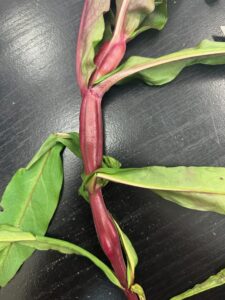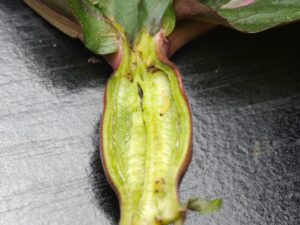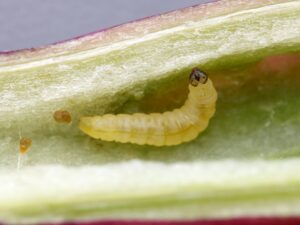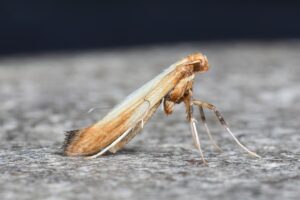Many Hoosier landscapes include flowering plants known as beardtongue or simply by its scientific name, Penstemon. This is the largest genus of flowering plants that is endemic to North America, with some 280 species spread throughout the continent – at least 11 of which are native to Indiana. Many of the cultivars planted in gardens are perennial plants with multiple stems and vibrant stems, leaves, and flowers.
- Figure 1. Penstemon sample with swollen stem galls.
Several Penstemon plants from a West Lafayette garden were observed in late May to have swollen stems and stunted growth (Fig. 1). I had the chance to examine them after they were submitted to the Plant & Pest Diagnostic Lab and found a surprise when the stems were cut open – caterpillars! (Figs. 2,3)
- Figure 2. Penstemon stem cut in half showing large empty chamber with small caterpillar.
- Figure 3. Caterpillar of the stem-galling moth, Caloptilia murtfeldtella.
I had not seen this pale 2mm beast before, but knew it was a member of a Gracillariidae, a family of moths that typically attack leaves where they chew “mines” by eating the fleshy inner parts of the leaf and leave the top and bottom epidermis layers as a protective barrier to the outside world. There are over 2000 species of this family around the world, but one unique species is found across North America and attacks Penstemon.
The insect in question is Caloptilia murtfeldtella (Busck) – one of many species that lacks a common name. It is very special within this family as it is one of a small handful of species that produces a stem gall. The caterpillar bores its way to the center of the stalk where it is able to co-opt the plant into producing a large, elongated piece of stem. The caterpillar feeds inside this pocket of freshly grown food before it is time to pupate into an adult moth, mate, and complete its life cycle. The species occurs across the northern United States and Canada from coast to coast and little is known about its host preferences or how severe of a problem it presents for Penstemon plants throughout the range. In the sample we received, every internode of the stems was at least slightly swollen, and each had a single caterpillar living inside. Adults seem to be active most of the summer, perhaps with two generations, and are commonly seen in May-June and September.
- Figure 4. Adult of the stem-galling moth, Caloptilia murtfeldtella. Photo credit: edporopat, iNaturalist https://www.inaturalist.org/photos/427862443
Control options are limited for this insect and lack any specific testing for this species, though systemic pesticides labeled for leaf miners and caterpillars should do the trick. Active ingredients such as Acetamiprid or Spinosad could be appropriate, but remember that systemic insecticides could negatively impact beneficial insects, including pollinator,s which would visit Penstemon.
Have you seen these symptoms in your own Penstemon plants? Submit samples to the PPDL if you suspect you are experiencing this too. And if you see a swollen stem, take a moment to admire the ingenuity of a moth caterpillar that has changed from the habits of its relatives and found a unique and prosperous way to make a living.



